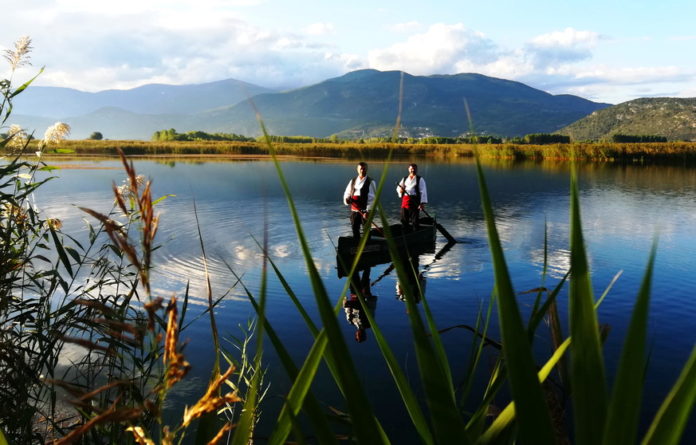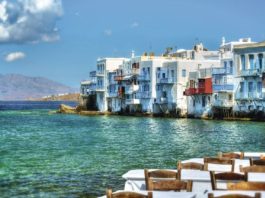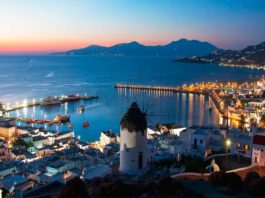Edessa, in the glorious Pella region, is famous all over Greece for its waterfall. Spectacular though it is, we found the region offers much more. This is an ideal destination in any season.
Edessa was our first stop on a fascinating exploration of the urban centers of Northern Greece with Pass2Greece, an organization that presents fascinating aspects of destinations for the curious and passionate traveler.
Table of Contents
Edessa – an Ideal Urban Destination
For dramatic natural settings, it doesn’t get better than Edessa. This charming traditional town is high on a cliff, over a fertile plain that stretches into the far distance. The town, especially the old district of Varotso, has a traditional character – stone houses and cobblestone lanes. The sound of water rushing through the canals of the town gives a sense of tranquility. The abundant water feeds the mighty plane trees throughout Edessa, making for refreshing shade from the summer heat, and beautiful trunks and branches in the light of winter.
The people of Edessa are the true draw though. This is a hospitable and unpretentious town, a town for locals who know how to live well. A convivial atmosphere fills the central square throughout the seasons, and even more so when the “Cantadores” – a group of strolling singers some 40 members strong, accompanied by guitar and accordion – serenade the town on brisk fall evenings.
The more we travel, exploring Greece together, the more we realize that what stays most in our minds is the human connection. No matter how beautiful the scenery, how fascinating the history, or how delicious the food, the people make the destination. By that measure, and many others, Edessa is one of the nicest places I’ve been in Greece.
The Karanos Waterfall and the Mills of Edessa

Greece’s most glorious waterfall fills the air with energy. It’s not just our imagination – the cubic tons of water falling from a height of 70 meters charge the air with negative ions. The air is so fresh and invigorating it’s almost delicious, to say nothing of the sound of the water crashing into the pools below. Due to mineral deposits, the waterfall cantilevers out from the cliff. You can now walk behind it to sense the drama of the pounding water, and gaze out onto the plain stretching out below as you take the sweet air in great gulps.
The Karanos waterfall is Greece’s largest. It now supplies energy to the national power company. But it once powered mills, including the Hemp Factory, one of Edessa’s chief sights.
The Old Hemp Factory of Edessa
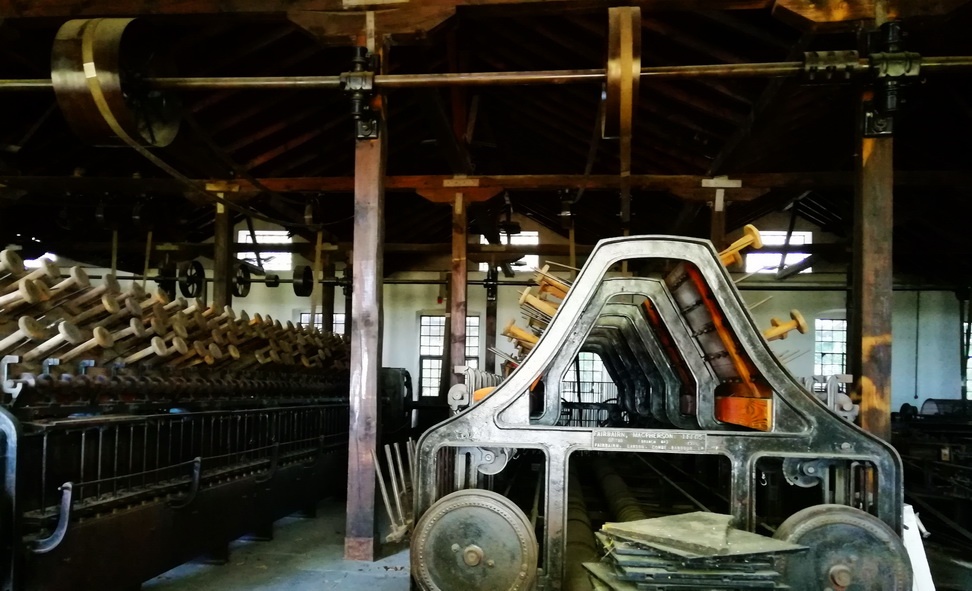
This gorgeous early 20th-century industrial ruin was once one of the four largest hemp factories in Greece. Powered by the mighty waterfalls, the factory produced rope from hemp imported from India as well as locally grown hemp from the area near Giannitsa. At the height of its production, from the later 1920s to the 1950s, the factory employed 150 people.
The factory closed in the 1960’s. It was finally was abandoned. Years later, it became a center for culture and entertainment. This is an elegant example of industrial architecture of the Belle Epoque, and the original machinery has a beautiful, sculptural presence.
The Reptile Museum of Edessa
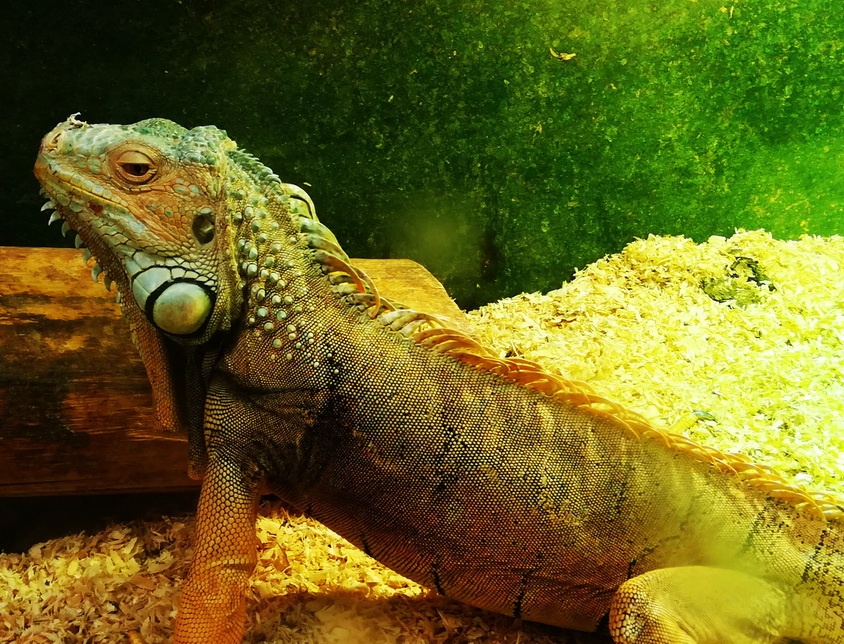
The Giannakis Watermill, one of the several watermills in Edessa, is now a Reptile House. This is a fantastic place to visit, whether or not you are visiting with children. But with children it’s a must. Magnificent snakes, lizards, turtles, and more are tended lovingly by the charismatic Dimitris Dourvanis, a passionate volunteer. Snakes are surprisingly silky. And the larger lizards are mesmerizing. This is a great place to have an up-close reptile experience.
Interestingly, none of the species here are local. These are all exotic foreign species. Wildlife preservation laws protect the Greek species. To see them, you will need to go exploring on your own, or visit another reptile center, somewhere else in Europe.
The Sesame Mill
When you think of Greece, you think of olive oil. But Edessa was not olive country. For centuries, the oil of choice was from sesame. In one of the old watermills, there is now a charming museum where you can see how sesame was ground and oil extracted, and watch a short, informative film on the history of sesame.
The Varosi Quarter
This historic quarter of Edessa is in the most dramatic spot of town, right at the cliff’s edge. Charming examples of vernacular architecture line the cobblestone streets. Some of the buildings are now traditional inns, with spectacular views of the plains far below.
The Church of the Assumption of the Virgin
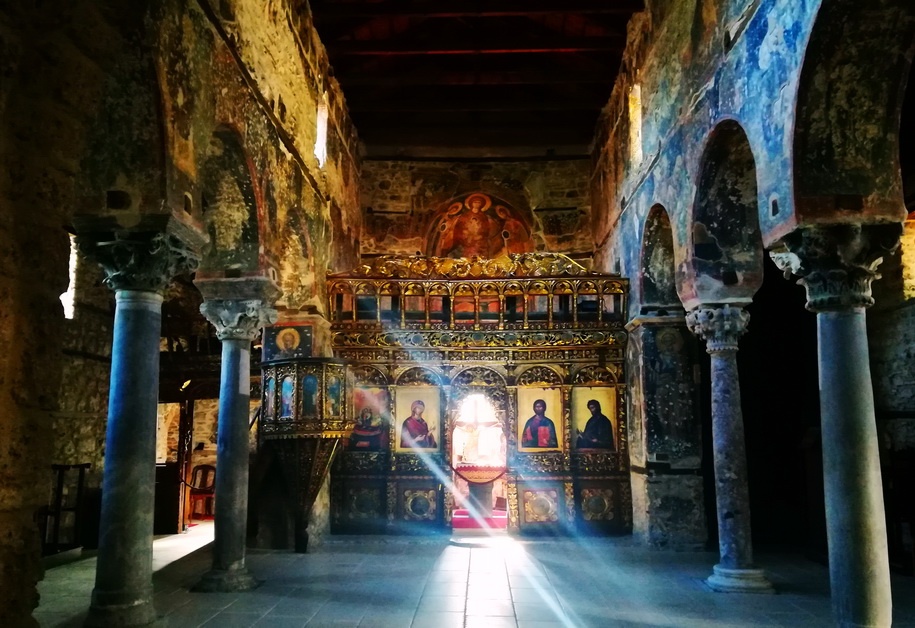
The Church of the Assumption is one of the most beautiful churches to see in Northern Greece. And that is saying a lot. This is a fragile building, open only a couple of times a year for special Masses, and otherwise just for quiet contemplation. There are no chairs, and the church is often empty.
The 14th century church is an excellent example of the Palaiologian Rennaissance. During the Byzantine Dynasty of the Palaiologos family – 1261-1453 – religious art flourished. Palailogian frescoes are famous for their magnificently expressive narrative power. These are fine examples, as moving in our contemporary era as they were centuries ago.
How the Church and the Frescoes of the Assumption of the Virgin Miraculously Survived- Twice
This was not always the church of the Assumption. It was once Agia Sophia. During the Ottoman reign, an order was sent to every province that any church called Agia Sophia was to be razed to the ground. The glorious Agia Sophia of Istanbul was to be the only Agia Sophia throughout the Ottoman Empire.
What the people of Edessa did was to remove a pillar from the front of the church and send it to Istanbul as proof of demotion. Then they renamed the church The Assumption of the Virgin.
The second miracle was a blessing very much in disguise. The magnificent frescoes are now pocked with holes, which actually is their salvation. When the Ottomans covered the Christian images, they made holes to give the plaster something to grab onto. During a restoration, these vivid frescoes were rediscovered, having been protected by the plaster for centuries. Without the holes, the plaster would have likely bonded to the surface of the frescoes, and they would have been irretrievably lost.
Dining (and Wining) in Edessa
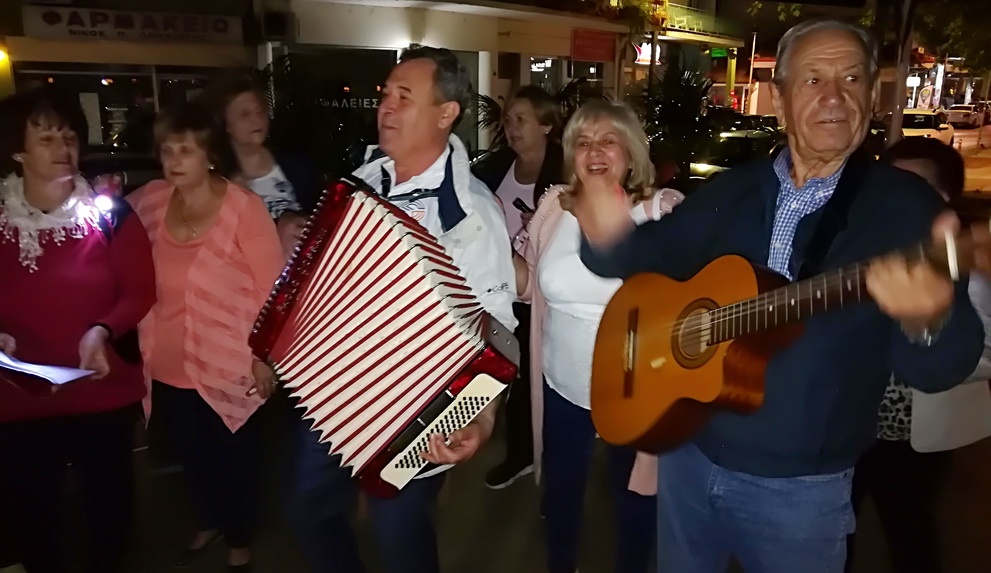
The tavernas and restaurants here are cooking for locals. That means prime local ingredients and regional specialties – food with tradition and deep roots. But the chefs are also young and ambitious and playful, so you get this sense of adventure and experimentation, along with classic princicipals of regional cooking. The results are excellent. We had dinner at the chic Kattaraktes, and had never had such delightfully rustic and authentic fine cuisine in such a modern setting.
You’ll want to make more of the evening, because Edessa is wonderful for a stroll at night. We ended up at charming Timenidon, in the town square amid the mighty plane trees, for some delicious local wine. It was here that we met the Cantadores.
Exploring the Edessa Region
This is some fantastic scenery. The natural setting is diverse, and includes a marvelous lake, a famous ski resort, and a natural hot springs spa. Additionally, it is full of adventure activities.
Adventure Activities Around Edessa
The Edessa Gliding Club offers lessons and accompanied flights. You can arrange to view the landscape on a glider ride with a pilot, on Sundays from April through October. Arrange in advance through the link above.
That sweeping plain and the dramatic cliffs make an ideal setting for Paragliding. We saw paragliders sailing silently above the landscape, enjoy the endless vistas. If you’re not a paraglider, you can take off with an expert- all you need to do is enjoy the ride.
Agios Athanasios
Agios Athanasios is the closest town to the slopes of Mt. Kaimaktsalan. “Kaimaki” means cream in Turkish, an allusion to the snow. The Kaimaktsalan Ski Center is one of the top ski destinations in Greece. Lifts bring you a thrilling 2500 meters above sea level for some great skiing.
But it’s not just the skiing – the town of Agios Athanasios itself is utterly charming. This traditional stone village at an altitude of 1200m is an attraction in itself. There are also accommodations that offer rustic elegance with an authentic sense of place, like the traditional stone guesthouse Rouga.
The dining in Agios Athanasios is also superb. At cozy Kalyva, in front of a roaring fire, we dined like hunters and foragers, on wild boar with red wine, and orzo with wild mushrooms.
Panagitsa
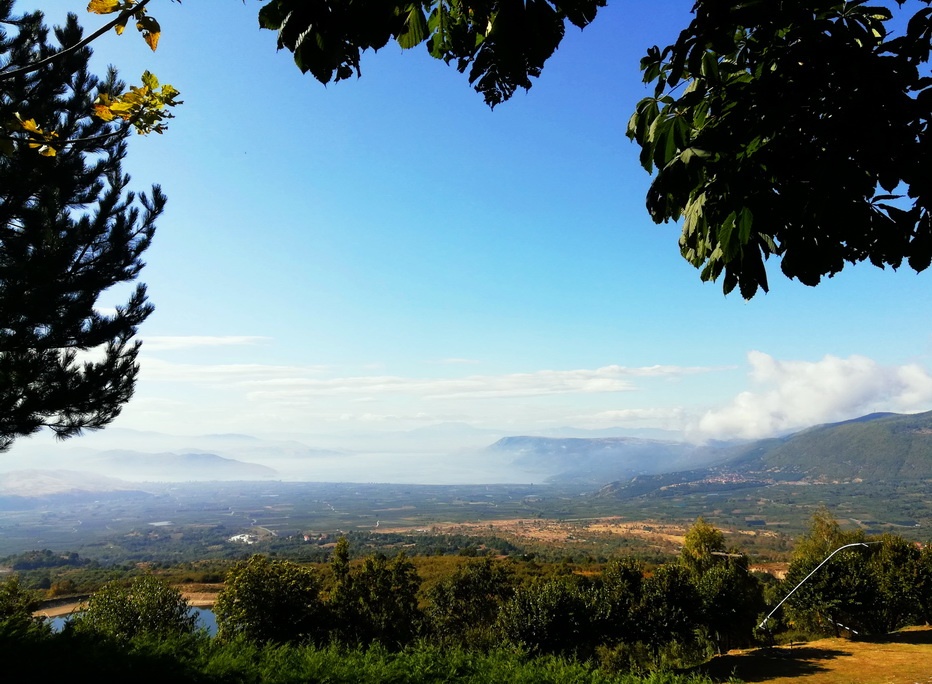
At the base of Mt. Kaimaktsalan is a beautiful spot for a hike and then a breakfast of homemade jam and bread and other house specialties at lovely Evora. The view is outstanding. But in winter you may enjoy it through the windows, from a chair beside the fireplace.
A True Art Hotel – Leventis Art Suites in Panagitsa

Lots of places go by the name of “Art Hotel” – a couple of original paintings, some vintage Phillipe Stark furniture, and voila – or so one hopes. These are not really art hotels – they are hotels with a little art in them.
Nothing can quite prepare you for the Leventis Art Suites experience. This truly is a complete work of art, a unique vision many years in the making. The principal areas of the hotel have sculpted walls and frescoes exploring central themes in a contiguous narrative. It is a bold grand-scale artwork, and a joy to inhabit. In the grand yet cozy suites, frescoes, antiques, design pieces, and contemporary fixtures harmoniously create uniquely beautiful environments. It’s almost a waste that this unique hotel experience is located in such a beautiful region – you’d honestly not want to leave. Fortunately, they do have a telescope, so you can stargaze from the comfort of the lounge, listening to their excellent collection of vinyl phonograph records and sipping good scotch.
Lake Vritta – A Protected Wetland and Bird Habitat
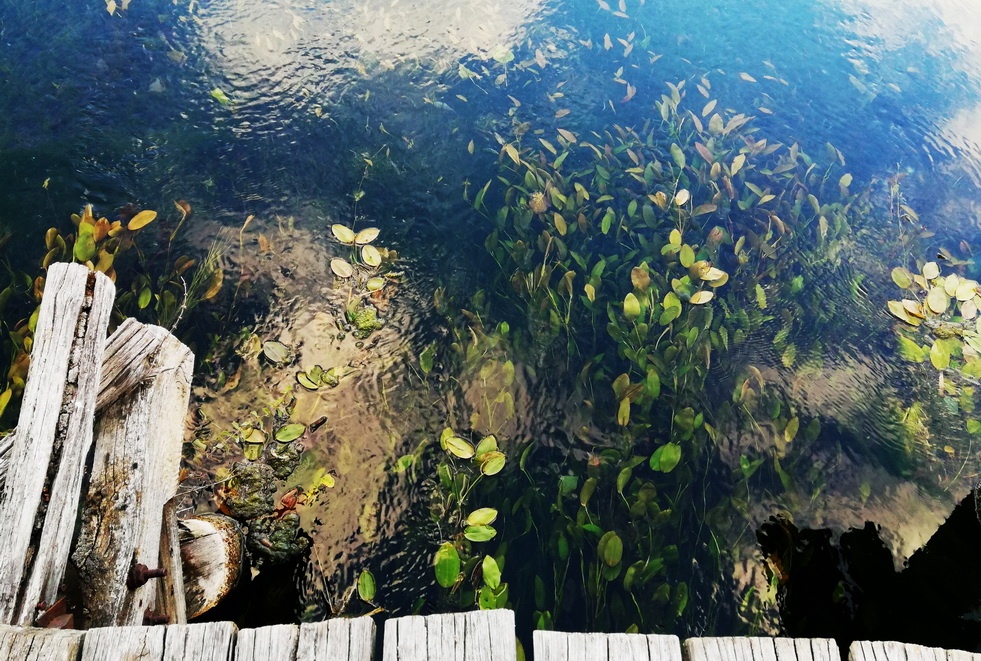
Amid all this beauty is a rich and diverse wetland. The glassy, reed-bordered Lake Vritta teems with rare and protected birds. Over 250 species call the lake home at some point during the year, and it is a wintering and breeding site for many birds.
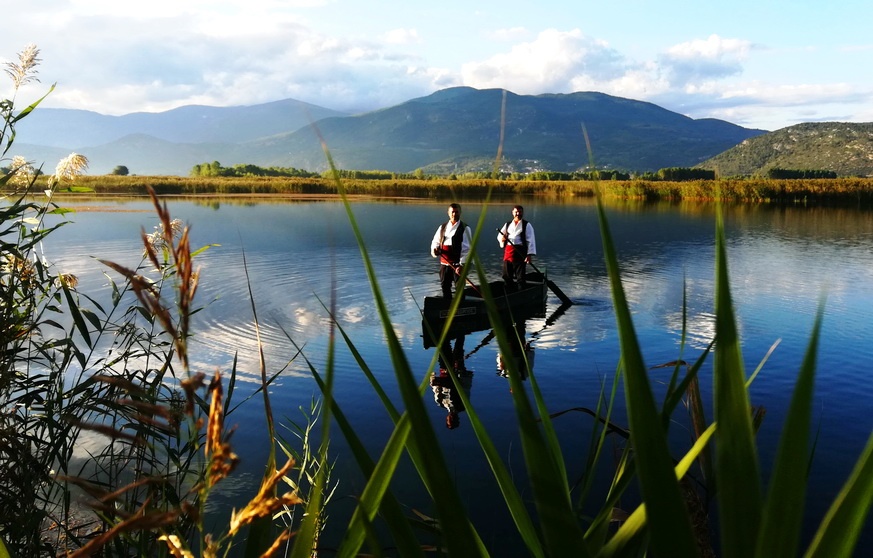
The day we saw Lake Vritta, it was not the birds we noticed at once. We were met with an astonishing site- men in the traditional costume of the time of the Balkan wars (1912-1913), boating silently among the reeds. In addition to being a nature preserve, this is also an area rich in history and heritage. Our local hosts gave us a rare experience, a living historical snapshot.
The lake is a must for amateur ornithologists, and indeed anyone who enjoys a day in a tranquil and idyllic setting. There is a shack where one can find out about organized rafting and bird-watching excursions, or enjoy a fine meal of fresh trout and local specialties.
Pozar- The Famous Natural Therapeutic Hot Springs of Pella
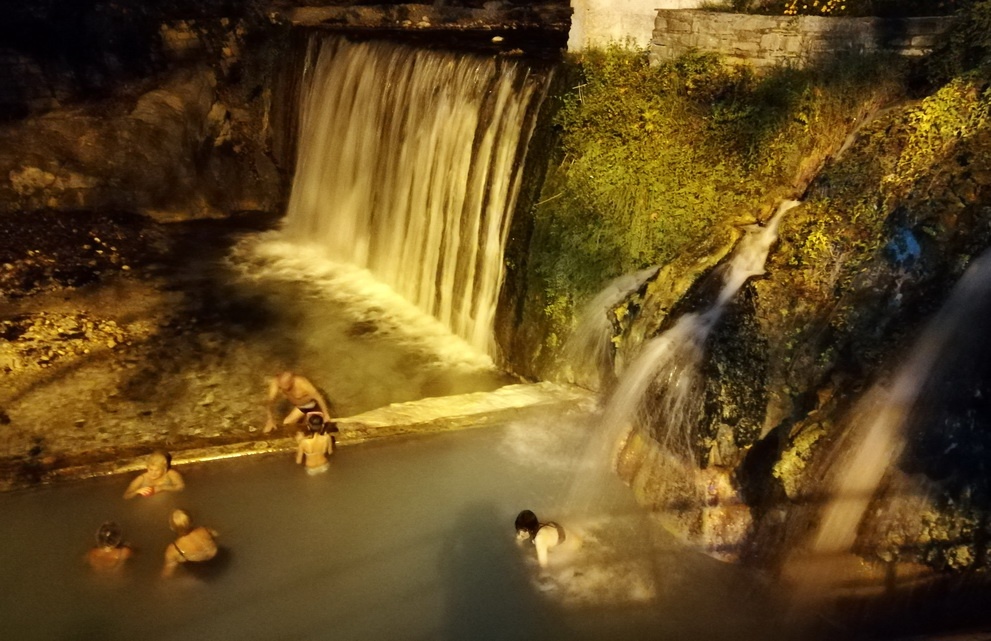
In a wooded wonderland is a uniquely pleasurable wellness destination, among the very best spa experiences in Northern Greece. The hot springs of Pozar flow at a cozy 37 C (99 F) degrees. The waters are rich in beneficial minerals, effective in targeting all manner of wellness issues. They are also great for relaxing and unwinding with friends. In fact, the baths are open 24 hours a day, so people can come here after a festive night out or a convivial evening with friends.
There are indoor private baths – never closed (book here) – and three outdoor pools. The grand, deep, 25 meter pool closes in the night for draining and refilling, while the wilder outdoor pool – including a hot waterfall – is open until the early hours. The river Thermapotamos flows fresh and cool alongside the wild pools. The river’s floor is white rocks and it cuts a bright and glowing path through the trees – a beautiful sight. Try to go early for a hike long its banks before you bathe. And treat yourself to a massage beforehand, too – there are excellent centers with skilled therapists and masseuses to help you make the most of the wellness experience.
Bring everything you need- towels, bath shoes, a hairdryer. Also – almost unfortunately – a bathing suit (mandatory) – you’ll want as little as possible between yourself and the water. You won’t need any lotion; the water will leave your skin baby-soft.
After a hike and a massage, then bathing in the warm springs, you’ll surely have an appetite. Not 2 minutes’ drive from the spa is Kokkino Piperi (“Red Pepper”). We had excellent local specialties, and platters of delicious fried peppers grown only in the region – some are hot, and some are not. Vegetarians will feast in style here, and the carnivores might join them, even though the meat selections were also excellent.
Staying in Edessa
There are many fine accommodations in town, both rustic inns and comfortable modern family hotels. We were at the Guesthouse Varosi, the Hagiati Guesthouse, and the Alfa Hotel – directly in the town center.
How to Get to Edessa
Edessa is about 100 km west of Thessaloniki – a little under an hour and a half by car, and much of the drive through beautiful and historic lands. It’s also a beautiful train trip through the countryside. The train station of Edessa is particularly charming, housed in its original building dating from the Ottoman era. Trains with direct routes depart from Thessaloniki five times daily, and the journey lasts about an hour and a half. The fare is €7 one-way.
Edessa- An Ideal Destination in Any Season
We discovered Edessa in the fall, with the leaves turning rich gold and rustling in the breezes. Already we’ve planned to come back when the branches are bare and there is the promise snow in the air – imagine soaking in the hot springs of Pozar, steam rising around you, beside the snow-covered banks. Spring around the lake must be beautiful. And under the heat of the strong Macedonian sun, there can be no place more refreshing than beside the Karanos waterfall or under the deep shade of Edessa’s plane trees, on the banks of the rivers running through town.

